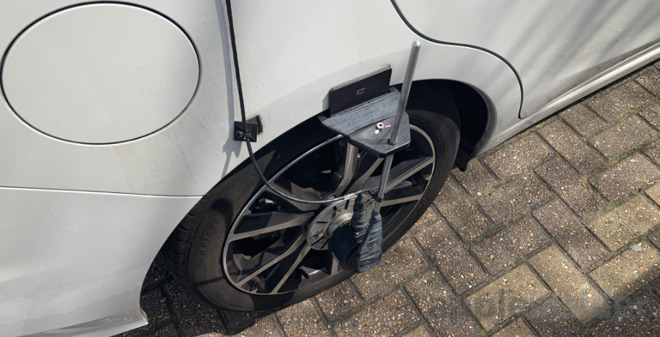Apple updating New York City map with greater detail, Look Around [u]
Apple has begun the roll-out of its updated maps for New York City, which include more transit information, better landmark detail, and also Look Around.

An Apple Maps car photographed in England in summer 2019
On Monday, Apple began rolling out its improved Apple Maps coverage of New York. The update is rolling out in phases according to Apple, and at the time of publication still isn't available to everyone in New York City yet. However, for some users the service is beginning to show the increased detail promised from Apple's program.
The improved coverage is also due to bring Apple's Look Around feature to New York, which mimics Google Street View to show how a journey would look on the ground.
"We have been driving and flying all across the United States, collecting land and aerial data to add significant new detail to the map, said Meg Frost, Apple's director of product design, at the launch of the new Maps in June.
Apple has reportedly only recently been undertaking its own photography, which means the company is more than a decade behind Google.
New York is the latest city to be updated, and follows others including Cupertino, San Francisco and Las Vegas.

Detail of the sensors attached to the wheels on an Apple Maps car
The updated maps detail is part of a relaunched Apple Maps which was released for iOS 13 and iPadOS 13. Apple continues to develop Apple Maps, with recent patents suggesting the company is investigating the use of virtual or augmented reality to aid navigation.
Update: Apple's Look Around feature is also coming to Los Angeles.

An Apple Maps car photographed in England in summer 2019
On Monday, Apple began rolling out its improved Apple Maps coverage of New York. The update is rolling out in phases according to Apple, and at the time of publication still isn't available to everyone in New York City yet. However, for some users the service is beginning to show the increased detail promised from Apple's program.
The improved coverage is also due to bring Apple's Look Around feature to New York, which mimics Google Street View to show how a journey would look on the ground.
"We have been driving and flying all across the United States, collecting land and aerial data to add significant new detail to the map, said Meg Frost, Apple's director of product design, at the launch of the new Maps in June.
Apple has reportedly only recently been undertaking its own photography, which means the company is more than a decade behind Google.
New York is the latest city to be updated, and follows others including Cupertino, San Francisco and Las Vegas.

Detail of the sensors attached to the wheels on an Apple Maps car
The updated maps detail is part of a relaunched Apple Maps which was released for iOS 13 and iPadOS 13. Apple continues to develop Apple Maps, with recent patents suggesting the company is investigating the use of virtual or augmented reality to aid navigation.
Update: Apple's Look Around feature is also coming to Los Angeles.

Comments
Navigation quality in Manhattan is quite uneven, to be generous. I don’t think it is possible for our devices to know with any accuracy where it is located. It’s the EMR noise of signals bouncing off the buildings, signal filtering, monster buildings preventing signals from every getting down to the street level. And, if you’re on the 19th floor of some building, the signals your phone will receive can tell it you’re located a couple of blocks away.
Now, at 1500 7th Ave, I connected Wi-Fi to the Starbucks/Google system at that address that would allow automatic connection at any Starbucks in the city as you get near, so I’m assuming Starbucks has fairly accurate location signaling set up. To navigate in NYC I think this technology would need to be ubiquitous.
Bluetooth/iBeacon would work, but accurate location data might have to await high frequency 5G with multiple antennas in every block and around corners.
Seriously though you would think they would have been able to cover most of the States by now. Those maps are extremely helpful, and probably cost next to nothing to produce (relatively speaking compared to driving every road in the US).